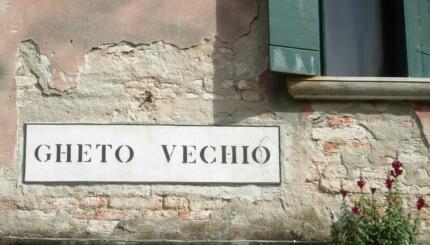Reprinted with permission from A Historical Atlas of the Jewish People, published by Schocken Books.
In the manner of other Mediterranean civilizations, the ancient Hebrews first used scrolls made of papyrus and later of leather parchment. Abundant samples are provided in the collections of papyri from Yeb (Elephantine), Assuan and Edfu in Egypt, the Dead Sea Scrolls, and the fragments found in the Judean Desert.
During the first centuries of the Christian era in the west and the Middle East, the scroll was gradually replaced by the codex: folded sheets sewn together in the middle–the book. The codex had obvious advantages over the scroll which was written only on one side of the parchment and was awkward to handle. By the fifth century AD the use of the scroll had disappeared almost entirely.
|
|
|
Image from a medieval edition of the Passover Haggadah. Photo: Ms. 444 First Cincinnati Haggadah, Klau Library, CincinnatiHebrew Union College-Jewish Institute of Religion |
The Jews, however, were slow to adopt the codex; its spread is attributed to Christianity. There are no extant Hebrew codices dated prior to the ninth or tenth centuries. But from the late Middle Ages thousands of manuscripts were preserved, written in Hebrew in a wide variety of styles from all over the diaspora.

Help us keep Jewish knowledge accessible to millions of people around the world.
Your donation to My Jewish Learning fuels endless journeys of Jewish discovery. With your help, My Jewish Learning can continue to provide nonstop opportunities for learning, connection and growth.
These surviving texts of both religious and secular works are but a minute portion of Jewish literary production during those centuries. Outstanding proof of the enormous amount of Jewish writing is provided by the Cairo Genizah–the immense archive containing over 50,000 worn and damaged books produced by the single community of Fostat (Old Cairo) in 250 years.
A treasure of invaluable historical and literary importance, the Genizah manuscripts are also objects reflecting the material and artistic culture which produced them. In these hand‑written books are harmoniously combined diverse technologies and handicrafts, the art of design and graphic creativity, the principles of two‑dimensional architecture and aesthetic traditions, literary and calligraphic styles, the art of illustration and illumination–a magnificent introduction to Jewish cultural history of the early Middle Ages.
The dispersion of a literate Jewish population contributed to the particularly wide geographical dissemination of Hebrew writing. Hebrew characters were also used for texts in other languages such as Aramaic or Arabic and German Jewish dialects. Hebrew books were produced in Christian Europe, in Muslim Spain, in North Africa, in the Near and Middle East, and as far as central Asia. Each geo-cultural area produced its own style in the art of the manuscript, exhibiting both the uniqueness and cohesion of the Jewish community as well as the influence of the local environment: Latin in western Christendom, Greek in the Byzantine sphere, Arab in the Muslim world.
The rich variety is particularly evident in the three types of script–square, mashait (intermediate), and cursive–but is revealed in other material and aesthetic elements as well: the parchment and later the paper, the ink, the collation of the sheets, design of binding and title page, illumination, and illustration. Over time six principal types evolved: (France, Germany, England, and central Europe); Italian; Spanish (Iberian peninsula, Provence, and North Africa); Byzantine; Oriental; and Yemenite.
The Second Commandment, prohibiting the making of “graven images,” did not prevent illumination of manuscripts during the Middle Ages. The style of illumination was dependent on contemporary fashions in each region. Thus it is difficult to define a Jewish style, although there are certain distinctively Jewish motifs.
For example, animal‑headed figures became one of the main Jewish motifs in southern German Hebrew illumination of the thirteenth and fourteenth centuries. The absence of capital letters in the Hebrew script led to the decoration of initial words, or sometimes whole verses. Another peculiar Jewish element was the use of minute script to form geometric or floral design.
The spread of the printing press in the sixteenth century signaled the end of the manuscript as an independent art. Although unpublished texts–and in more impoverished regions even printed works–continued to be copied by hand until recent times, these were essentially imitations of printing.
The traditional division into types of script disappeared not only because of the printed letter, but also as a result of the expulsion from Spain and the settlement of Iberian Jews in other places. Nevertheless, the art of the manuscript was revived in the eighteenth century in central Europe and in Germany with the fashion of copying illuminated Passover Haggadot and books of blessings.
The tradition of copying the Pentateuch on scrolls to be read in synagogues, as well as phylacteries, mezuzot, and divorce bills, continues to this day. Written in minute script, following strict rules, this work is done by specially trained expert scribes (sofer setam).



